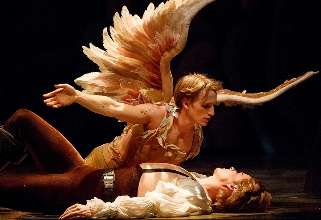|
Back
A dazzling show Toronto
The Elgin Theatre
04/14/2012 - &April 15, 17, 18, 20, 21, 2012
Jean-Baptiste Lully: Armide
Peggy Kriha Dye (Armide), Colin Ainsworth (Renaud), Joao Fernandes (Hidraot), Vasil Garvanliev (Aronte), Carla Huhtanen (Phénice/Lucinde), Olivier Laquerre (Artémidore/Chevalier Ubalde), Aaron Ferguson (Chevalier Danois), Meghan Lindsay (Sidonie/Nymphe des Eaux), Curtis Sullivan (La Haine), Jack Rennie (L’Amour)
Tafelmusik Baroque Orchestra and Chamber Choir, Ivars Taurins (Choir Director), David Fallis (Conductor)
Marshal Pynkoski (Director), Jeannette Lajeunesse-Zingg (Choreographer), Gerard Gauci (Set Designer), Dora Rust D’Eye (Costume Designer), Bonnie Beecher (Lighting Designer)

J. Rennie & C. Ainsworth (© Bruce Zinger)
Of all the Opera Atelier productions I have seen over the past 26 years, this production of Lully’s Armide comes closest to what this unique company is all about.
The work was composed in 1686 and is a prime example of the first generation of French opera when it was still very much an outgrowth of the aristocratic court ballet so beloved of Louis XIV. A good half of the work is danced, a fact that dismays not a few opera buffs. In addition, most of the vocal lines consist of recitative and only at a few climactic points does a singer break into a brief proto-aria. Happily, the company style wrings the maximum drama from recitative - this has been demonstrated in every production over the past few years. And of course the drama is further heightened when arioso passages emerge.
The plot is straightforward, involving the forbidden love between two avowed enemies (to whit, a crusading knight and a Saracen sorceress). (It prefigures the plot of Tristan und Isolde in its own singular way.) It is termed a tragédie en musique and in some ways looks forward to opera seria, but avoids the fanciful entanglements that are such a feature of that genre. With a running time of about two and one-half hours OA omits the allegorical prologue which has La Gloire (Glory) and La Sagesse (Wisdom) discussing ideas we are to see played out in the drama - this is no loss.
Even though it is a tragedy (although nobody dies - the two enamoured enemies part sadder and wiser) there is comic relief in Act IV when two of Renaud’s fellow knights (played by Olivier Laquerre and Aaron Ferguson) have to resist the blandishments of two of Armide’s seductive cohorts (Carla Huhtanen and Meghan Lindsay).
The dramatic high point occurs in the third of the five acts, when Armide approaches La Haine (Hatred) pleading to have her love for Renaud turned into hatred. L’Amour (Love), personified by dancer Jack Rennie, (see photo above) is lashed by Hatred’s demonic minions. Armide then succumbs to her finer feelings and Hatred rejects her. The scene is played as a wonderful amalgam of singing, dance and stylized movement - not to mention sumptuous design and emphatic orchestral playing.
The singing ranges from just fine to terrific. The title role really carries the show, and Peggy Kriha Dye (in her 10th role with OA) rises superbly to the occasion. Her final scene where she gives way to anguish makes for a truly breathtaking finale. In his introductory remarks, director Marshall Pynkoski told us that they rehearsed this scene with the full battery of stage effects (smoke, lightening, you name it) but at the last minute decided to let the singer hold the stage unaided. One can’t imagine it any other way.
The other main role is that of Renaud (Rinaldo in other operas, as in Torquato Tasso’s poem, Gerusalemme Liberato). Colin Ainsworth’s voice has acquired greater heft recently without losing its fresh, youthful quality. He sang the role in 2005 and, thanks to his many appearances with AO, is marvelously adept at the company’s style.
Outstanding in the shorter roles are Curtis Sullivan as the vehement La Haine and Meghan Lindsay displaying vocal charm and sparkle in her two roles. The Tafelmusik Baroque Orchestra (30 players strong for this production - with two continuo groups) supplies its usual firm and colourful support under David Fallis, while the 20-voice chamber choir, singing from stage boxes as a chorus (i.e. from memory) also manage to have just the right sound for the work. Fifteen members of the Atelier Ballet are given a lot to do - especially the men - and carry it off with their accustomed élan.
This production was first presented in 2005. Given that it is about to be presented in May at the Théâtre Royal in Versailles and then this summer at Glimmerglass, more money has been spent on the designs, boosting them from lavish to dazzling.
The company has announced its plans for 2012-13, with a major surprise this fall: Carl Maria von Weber’s Der Freischütz, which will be their first 19th-century work. They will also be reviving their much-loved Die Zauberflöte or, since it will be presented in English, The Magic Flute.
Michael Johnson
|